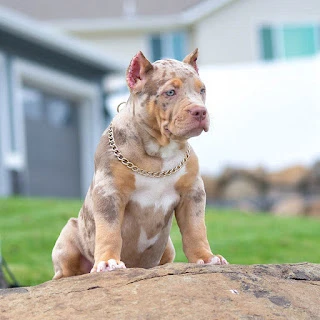The American Bully, a breed known for its robust physique and friendly demeanor, has captivated dog enthusiasts worldwide. Among the various coat patterns that make this breed stand out, the merle color pattern is particularly fascinating. This article delves into the intricate details of the Merle color American bullies, exploring its genetic origins, health implications, and the controversy surrounding it.
Understanding the Merle Color Pattern
The merle color pattern is characterized by a mottled appearance, with patches of diluted pigment interspersed with the dog’s base color. This creates a unique, marbled effect that can be seen in various hues, including blue, red, and fawn. The merle gene (M locus) is responsible for this distinctive pattern and is an incomplete dominant gene, meaning that a dog needs only one copy of the merle gene to display the merle coat.
In American Bullies, the merle pattern can present itself in numerous ways, from subtle spots to large, striking patches. The appeal of this coat pattern lies in its unpredictability and the one-of-a-kind appearance it bestows upon each dog.
Genetic Mechanics of the Merle Pattern
The genetic mechanism behind the merle coat involves a mutation in the PMEL (premelanosome) gene. This mutation causes random dilution of the pigment, leading to the characteristic patches of lighter color. Dogs that inherit one merle gene (Mm) will exhibit the merle pattern, while those with two merle genes (MM) are referred to as double merles.
Double merles often have predominantly white coats with minimal merle patches. They are at a significantly higher risk for various health issues, including deafness, blindness, and other eye anomalies. This is due to the excessive dilution of pigment, which is crucial for the normal development of certain structures in the eyes and ears.
Health Implications and Ethical Considerations
Breeding merle American Bullies requires careful consideration due to the potential health risks associated with the merle gene, particularly the double merle. Double merle dogs are prone to serious congenital defects, and ethical breeders avoid pairing two merle dogs to prevent these outcomes. Responsible breeding practices involve genetic testing and selecting pairings that minimize the risk of producing double merle offspring.
The American Bully breed itself is known for its sturdy health compared to some other breeds, but the introduction of the merle gene can complicate this. Prospective owners of merle American Bullies should be informed about these potential health issues and ensure that their dogs come from reputable breeders who prioritize health and genetic integrity.
The Controversy Surrounding Merle American Bullies
The merle pattern, while visually striking, has sparked controversy within the dog breeding community. Some breed registries, including the American Kennel Club (AKC), do not recognize the merle coat in certain breeds due to the associated health risks. However, the American Bully Kennel Club (ABKC) does recognize merle American Bullies, provided they meet the breed standard and are not double merles.
Critics argue that promoting merle dogs can inadvertently encourage irresponsible breeding practices aimed at producing aesthetically appealing dogs at the expense of their health. On the other hand, proponents believe that with careful, responsible breeding, it is possible to enjoy the beauty of the merle pattern without compromising the well-being of the dogs.
Caring for a Merle American Bully
Owning a merle American Bully comes with specific considerations to ensure their health and happiness. Regular veterinary check-ups are crucial to monitor for any signs of the health issues associated with the merle gene. Special attention should be given to their eyes and ears, as these are the areas most commonly affected by merle-associated conditions.
In terms of general care, American Bullies are relatively low-maintenance. Their short coats require minimal grooming, although regular brushing helps keep their skin healthy and free from irritations. Due to their muscular build, they benefit from regular exercise to maintain their physical and mental well-being. Providing a balanced diet that meets their nutritional needs is also essential for their overall health.
The Aesthetic Appeal and Popularity
Despite the controversies, the merle American Bully’s aesthetic appeal cannot be denied. Their unique, marbled coats set them apart, making them highly sought after by dog enthusiasts who appreciate their distinctive look. The rise in popularity of merle American Bullies can also be attributed to social media, where their striking appearance often garners significant attention.
Conclusion
The Merle color American bullies is a testament to the fascinating world of canine genetics. While it brings undeniable beauty and uniqueness to the breed, it also necessitates a high level of responsibility from breeders and owners alike. Understanding the genetic implications and health risks associated with the merle gene is crucial for anyone considering adding a merle American Bully to their family.
Ethical breeding practices and informed ownership can ensure that these stunning dogs lead healthy, happy lives. As with any breed, the priority should always be the well-being of the dog, ensuring that the allure of their appearance does not overshadow the importance of their health and quality of life.



